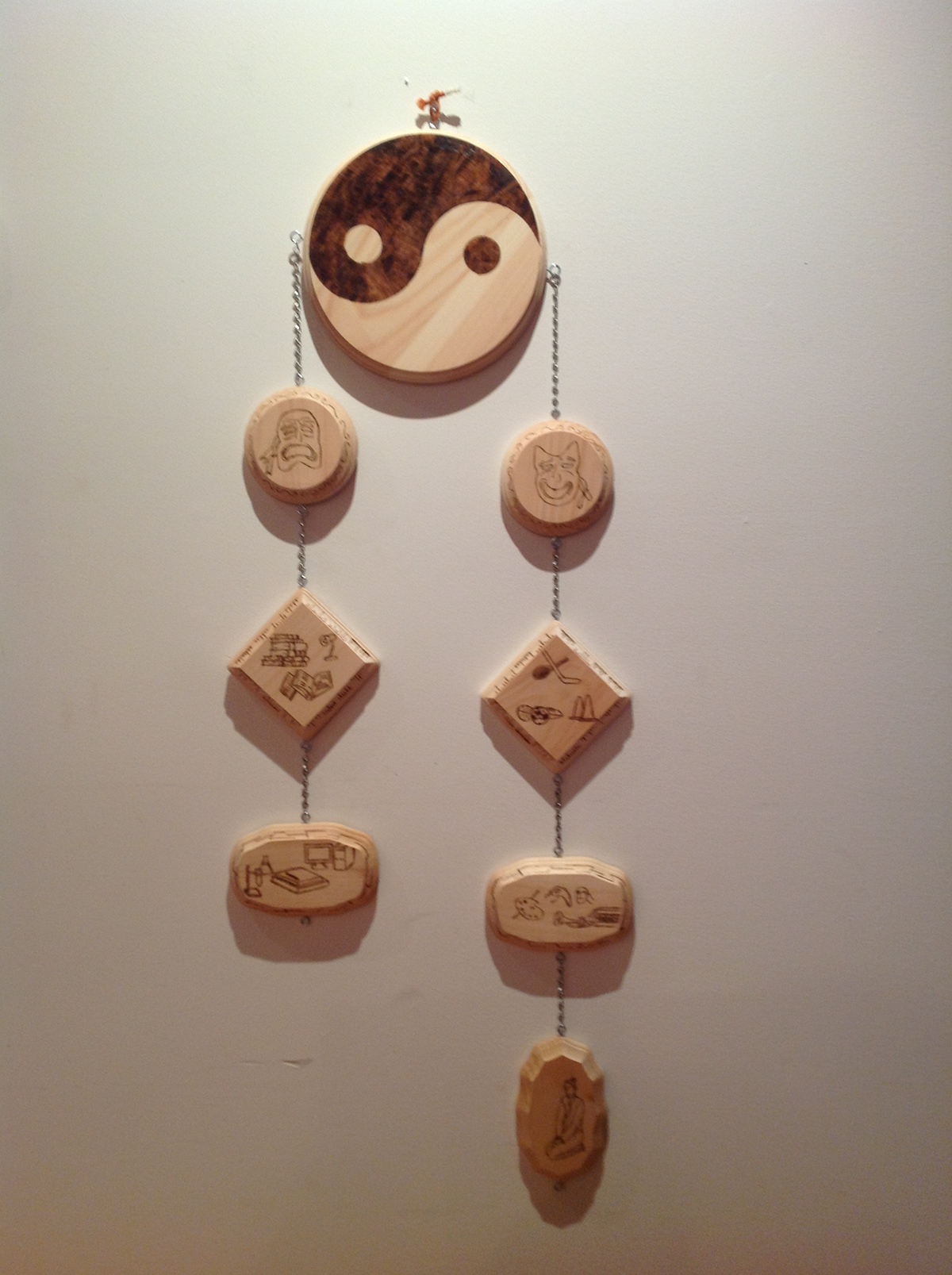At the center of this philosophy and of these scales is a recognizable emblem, Yin and Yang, which represents balance and duality. The emblem draws upon a representation of night and day, recognizing that darkness and light cannot exist without reference to one another. Thus, as there will be darkness in your life there will also be light. It is your duty to keep the two in balance.

The drops are arranged such that Yin points down and Yang up, so as to represent pressures and stresses descending on everyday life but joys and releases pushing up through it as well. My own interpretation of this emblem differs from a common perception of simple division or opposition. My interpretation holds that, just as the two sides hold each other's essence at their core, neither can truly exist without the other, therefore they are not opposites, but complements; two parts of the same whole.

The first hanging tiles are emblazoned with the masks of tragedy and comedy. These masks are recognizable as a common feature in the theater, but here they hang opposed to one another on the Yin and Yang side respectively. They represent the emotional scales, which the theater is particularly adept at evoking. The tiles upon which these masks sit are simple circles, representing the simplicity of the concept but also it's structural importance. In the classroom it is important to learn not only how to recognize and deal with your own emotions but also how to wear an appropriate mask to keep others safe from your own negative emotions.

The next set of tiles, presented on simple squares, are emblazoned with sports equipment on the Yang side and a stack of books on the Yin side. These two tiles represent study and play, two aspects of childhood and of adult life which are all too often neglected or over-emphasized, especially in school and education. As in all aspects of life, it is important, both for the teacher and for the students, to strike a balance between these two aspects.

These tiles take a sharp increase in structural complexity, representing simultaneously that we are moving to higher order thoughts and concepts, but also that the base upon which they are built is much more elaborate and complicated. These tiles are marked with representations of academia on the Yin side and representations of the arts on the Yang. These aspects of education are often viewed as opposites, however both give children opportunities to exercise their creativity and problem-solving in different ways, therefore they are not opposites but compliments; two parts of the full education.

The last pair of this set are much more complicated in their shape representing my own personal ideal of educational
philosophy, namely my preferred martial art Aikido. In Aikido the primary philosophy holds that when defending yourself, you should not injure your opponent simply to accomplish that goal. The key to proper exercise of the control needed to protect yourself and your opponent lies in finding and using your center. The martial art itself focuses on manipulating your opponent's body so that you have full control over the entire encounter, but to do this you have to use gentle techniques and keep a calm and clear mind. Thus it is equally important to practice the physical techniques of the martial art and the meditative aspects in order to grasp both the philosophy and the practice.
philosophy, namely my preferred martial art Aikido. In Aikido the primary philosophy holds that when defending yourself, you should not injure your opponent simply to accomplish that goal. The key to proper exercise of the control needed to protect yourself and your opponent lies in finding and using your center. The martial art itself focuses on manipulating your opponent's body so that you have full control over the entire encounter, but to do this you have to use gentle techniques and keep a calm and clear mind. Thus it is equally important to practice the physical techniques of the martial art and the meditative aspects in order to grasp both the philosophy and the practice.

The unused hooks at the bottom of the last tiles are meant to represent the potential for further growth which is always present throughout your life.

The scale aspect of this model is important because it demonstrates how a lack of balance in development can offset any progress you make in other areas. For instance, if you develop very strongly in emotional balance but then continue to develop only in play and arts, then the emotional balance will be offset by the development of the other two areas without their complementary aspects.

This imbalance is less noticeable the more aspects you develop in tandem but it does still exist.

